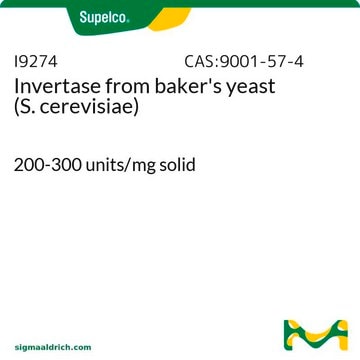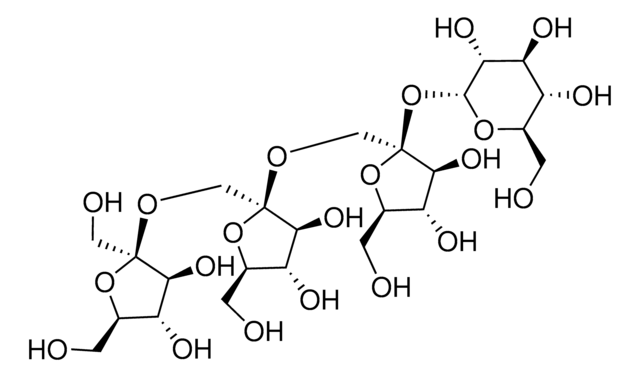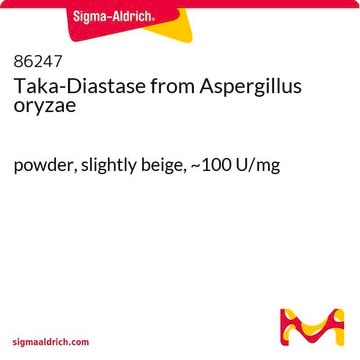57620
Inulinase from Aspergillus niger
lyophilized, powder, brown-gray, ~25 U/mg
Sign Into View Organizational & Contract Pricing
All Photos(1)
About This Item
Recommended Products
biological source
Aspergillus niger
form
powder
quality
lyophilized
specific activity
~25 U/mg
color
brown-gray
storage temp.
2-8°C
General description
Inulinases are classified as exoinulinases and endoinulinases.
Application
Inulinase from Aspergillus niger has been used as a glycoside hydrolase (GH) to study its potential to disperse bacteria (P. aeruginosa and S. aureus) from microbial biofilms using a polymicrobial well-plate model.
Biochem/physiol Actions
Inulinase hydrolyses inulin to produce oligosaccharides and liberate fructose. It also splits the terminal fructose units into sucrose and raffinose.
Inulinase is used in high-fructose syrup, which has therapeutic applications. Inulinase is reported to have high activity toward sucrose.
Unit Definition
1 U corresponds to the amount of enzyme which releases 1 μmol of reducing sugar (measured as fructose) per minute at pH 4.1 and 37°C from inulin
Signal Word
Danger
Hazard Statements
Precautionary Statements
Hazard Classifications
Resp. Sens. 1
Storage Class Code
11 - Combustible Solids
WGK
WGK 1
Flash Point(F)
Not applicable
Flash Point(C)
Not applicable
Personal Protective Equipment
dust mask type N95 (US), Eyeshields, Gloves
Choose from one of the most recent versions:
Already Own This Product?
Find documentation for the products that you have recently purchased in the Document Library.
Customers Also Viewed
R. Azhari et al.
Biotechnology and Applied Biochemistry, 11, 105-105 (1989)
Shinya Kuzuwa et al.
Gene, 495(2), 154-162 (2011-12-27)
Though some genetic features of lactobacillar fructan hydrolases were elucidated, information about their enzymology or mutational analyses were scarce. Lactobacillus casei IAM1045 exhibits extracellular activity degrading inulin. After partial purification of the inulin-degrading protein from the spent culture medium, several
Aline Richetti et al.
Bioprocess and biosystems engineering, 35(3), 383-388 (2011-08-13)
An experimental design was carried out to evaluate the effect of the concentrations of sodium alginate, glutaraldehyde and activated coal on the immobilization of inulinase from Kluyveromyces marxianus NRRL Y-7571. The experimental condition of 20 g/L of sodium alginate, 50 mL/L of
C Neagu Bonciu et al.
Letters in applied microbiology, 55(3), 195-201 (2012-06-26)
A newly isolated strain of Rhizoctonia ssp. was used for the production of extracellular inulinase. Previously, the qualitative effects of some carbon and nitrogen sources from fermentative media and the physicochemical parameters for growth were established by Plackett-Burman analysis, and
L Wang et al.
Journal of applied microbiology, 111(6), 1371-1380 (2011-09-08)
The aim of this study is to improve exoinulinase production by expression of a cloned exoinulinase gene inuA1 (GenBank accession no. JF961344) from Penicillium janthinellum strain B01 in Pichia pastoris. A full-length cDNA of exoinulinase gene (inuA1) was cloned from
Our team of scientists has experience in all areas of research including Life Science, Material Science, Chemical Synthesis, Chromatography, Analytical and many others.
Contact Technical Service













